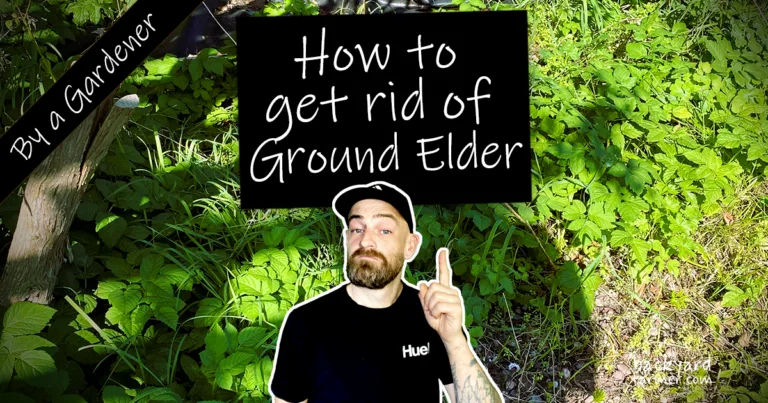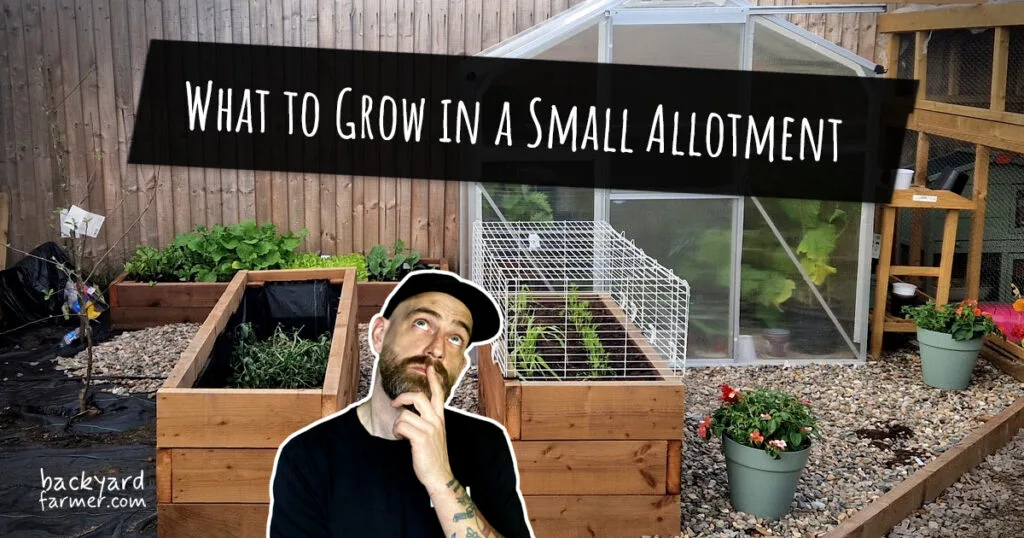Table of contents
- Introduction: How to Get Rid of Ground Elder
- What is Ground Elder?
- How to Identify Ground Elder
- Why is Ground Elder Hard to Remove?
- How to Get Rid of Ground Elder: Best Methods That Work
- Does Boiling Water or Vinegar Help Get Rid of Ground Elder?
- Why You Should Avoid Chemicals
- Can You Live with Ground Elder?
- Is Ground Elder Edible?
- Final Tips for Long-Term Ground Elder Control
- Ground Elder FAQs – How to Remove, Kill, and Compost It Safely
- Conclusion
Introduction: How to Get Rid of Ground Elder
How to get rid of ground elder is a challenge many gardeners face. Originally introduced to the UK by the Romans as a food source, it has since become a relentless invader in many gardens. Thanks to its aggressive underground rhizomes, it spreads quickly, creeping through flower beds, borders, and even neglected grassy areas before you know it.
Wondering how to get rid of ground elder in the UK? This guide covers natural and eco-friendly ways British gardeners can control it effectively. Wondering how to get rid of ground elder? The key is persistence and the right approach to weaken its spread over time.
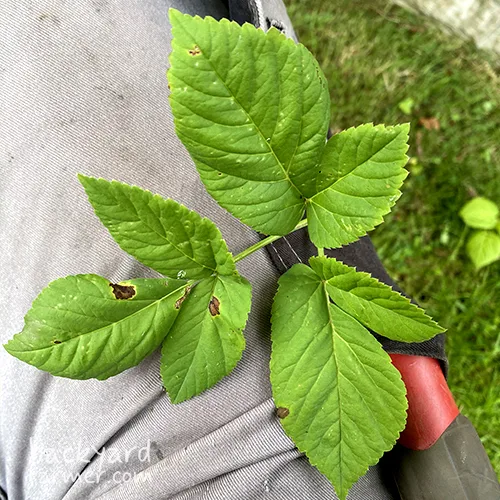
The Challenge of Ground Elder
- Spreads rapidly: Underground rhizomes help it multiply and take over.
- Hard to eliminate: Even tiny root fragments left behind can regrow.
- Competes with other plants: Steals nutrients, space, and light from your garden favorites.
Can You Ever Fully Get Rid of Ground Elder for Good?
Getting rid of ground elder entirely is difficult, but controlling it is absolutely possible! With the right strategies and a little patience, you can keep it in check and stop it from overwhelming your garden.
What This Guide Covers
- Manual removal techniques – The best tools and methods to dig it out.
- Smothering & eco-friendly solutions – Ways to starve it without chemicals.
- Long-term prevention strategies – How to stop it from coming back.
Whether you’re dealing with a small patch or a full-blown invasion, this guide will help you find the best approach to manage ground elder—without resorting to harmful chemicals.
Let’s dive in and reclaim your garden!
What is Ground Elder?
Ground elder (Aegopodium podagraria) is a fast-spreading perennial weed that can quickly take over gardens, borders, and neglected grassy areas if left unchecked. Originally introduced to the UK by the Romans as a food source, it has since become a persistent nuisance for gardeners.
How It Spreads
This invasive weed spreads primarily through underground rhizomes, which form an extensive root network beneath the soil. Even the smallest root fragment left behind can regenerate into a new plant, making complete removal extremely difficult. While it does produce seeds, its main method of spreading is through rhizomes, making it especially tricky to control.
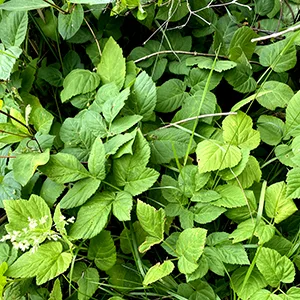
How to Identify Ground Elder
When identifying ground elder, look for its distinctive ground elder leaf shape — bright green, with three to five toothed leaflets per stem that resemble elder tree foliage.
- Leaves: Bright green, with three to five leaflets per stem, resembling elder tree leaves.
- Flowers: Small, white, and grouped in umbrella-like clusters, blooming in late spring to early summer.
- Roots: Thin, white rhizomes that creep horizontally just beneath the soil surface.
- Growth Pattern: Forms dense clusters that can quickly dominate an area.
Why is Ground Elder a Problem?
- Highly invasive: Spreads rapidly and outcompetes other plants.
- Difficult to remove: Even tiny root fragments can regrow into full plants.
- Smothers garden plants: Competes for space, nutrients, and sunlight.
- Persistent: Requires ongoing management to prevent it from taking over.
Despite its bad reputation, some gardeners choose to coexist with ground elder by keeping it in check through regular maintenance—or even incorporating it into foraging and cooking, as it’s entirely edible!
How to Identify Ground Elder
Ground elder (Aegopodium podagraria) is often mistaken for other plants because of its similar leaf shape. However, once you know its key features, you’ll be able to spot it easily and take steps to keep it under control.
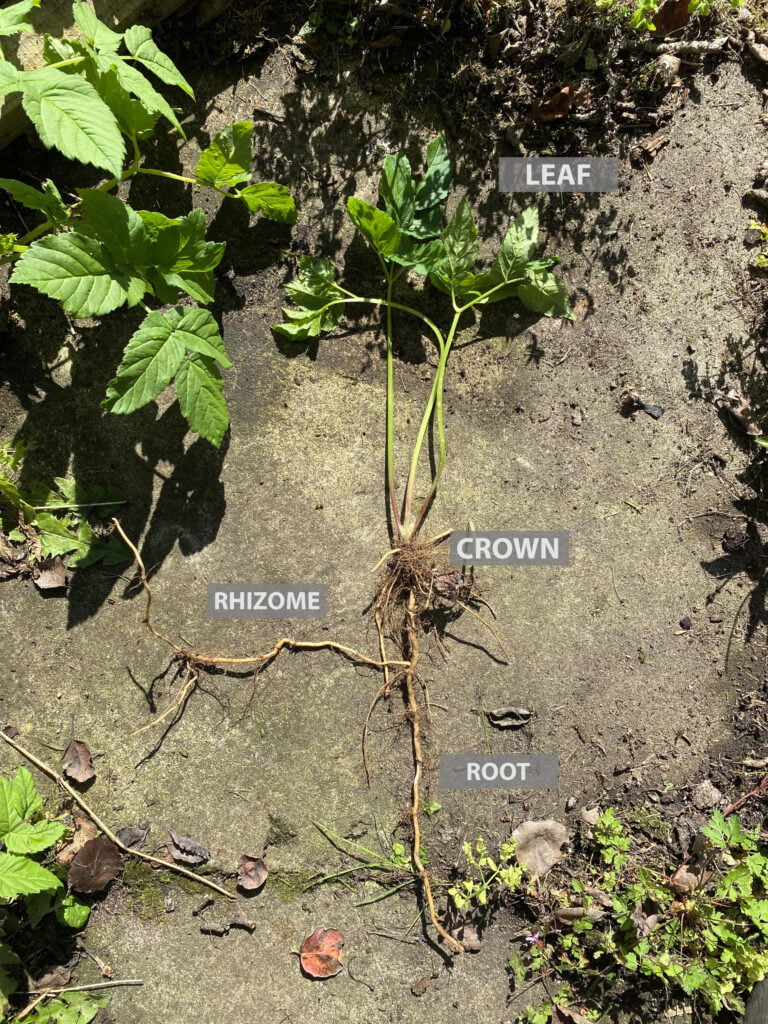
Key Characteristics of Ground Elder
Leaves
- Bright green and similar in shape to elder tree leaves.
- Each stem has three to five leaflets, forming a distinct triangular pattern.
- The edges are serrated, giving them a slightly jagged appearance.
- Key Difference: Unlike true elder (Sambucus nigra), ground elder’s leaves lack a strong scent when crushed.
Roots and Growth Pattern
- Spreads through thin, white rhizomes that creep just below the soil surface.
- Forms dense clusters, quickly overtaking garden beds.
- Difficult to remove because even tiny root fragments can regenerate.
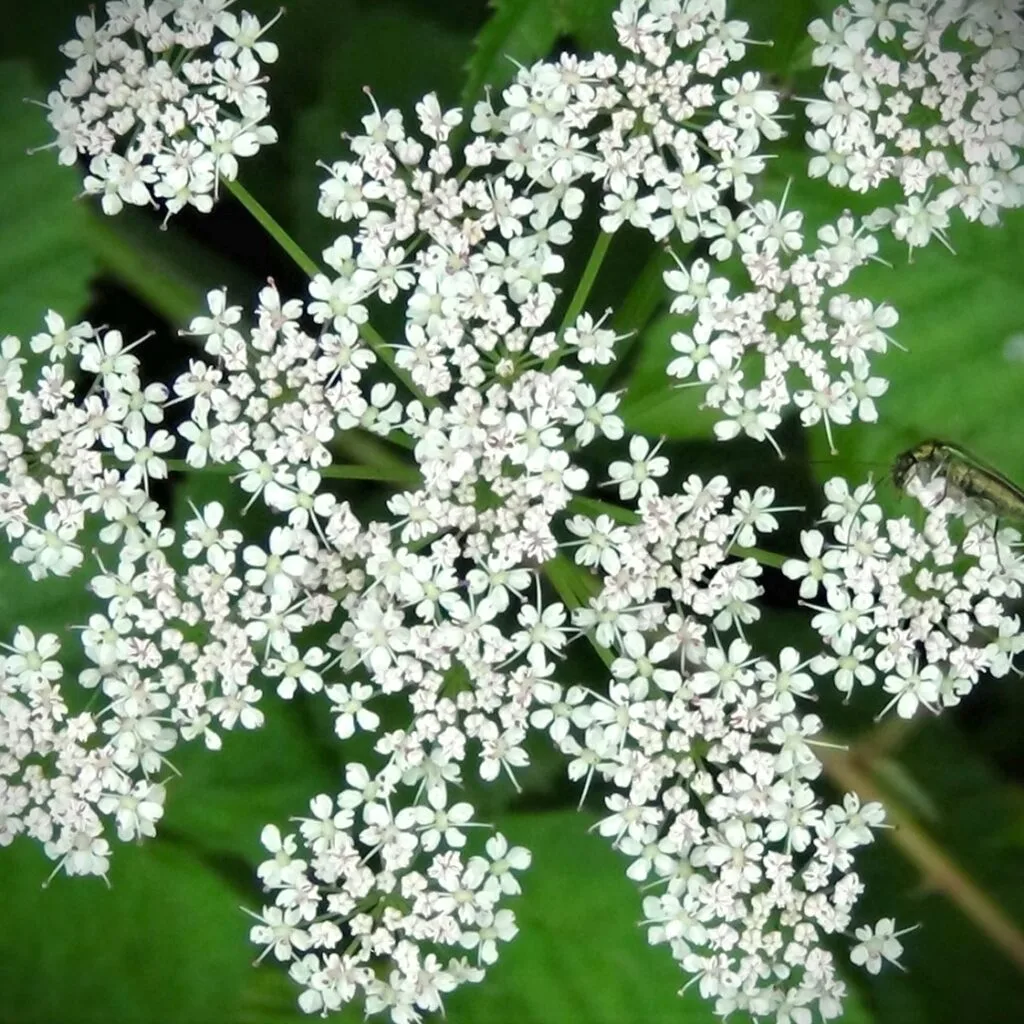
Flowers
- Small, white, umbrella-like clusters known as umbels.
- Bloom in late spring to early summer.
- Resemble cow parsley but are typically smaller and more compact.
Stem and Height
- Hollow, green stems with a slightly ridged texture.
- Typically grows 30-90 cm tall, depending on conditions.
Common Lookalikes
- Cow parsley (Anthriscus sylvestris) – Taller, with feathery foliage.
- Elder (tree) (Sambucus nigra) – Has larger leaves and woody stems.
- Angelica (Angelica sylvestris) – Features thicker stems and broader leaves.
By recognizing these key features, you can confidently identify ground elder and take action before it spreads too far!
Why is Ground Elder Hard to Remove?
Ground elder (Aegopodium podagraria) is one of the most stubborn and persistent weeds you’ll ever encounter. It spreads rapidly, regenerates easily, and resists many common weeding methods. Even when you think you’ve eliminated it, a tiny leftover root fragment can restart the cycle. Here’s why this plant is so challenging—and what you can do about it.
Spreading Through Underground Rhizomes
- Ground elder spreads aggressively through thin, white rhizomes just beneath the soil surface.
- These rhizomes act like underground runners, allowing the plant to travel quickly and take over large areas.
- Even if you remove most of the plant, any small rhizome fragments left behind can regrow into new plants.
Regenerating from Small Fragments
- Unlike some weeds that die off when cut, ground elder can reproduce from even the tiniest root segments.
- If a small piece of rhizome remains in the soil, it will sprout new shoots, making full removal incredibly difficult.
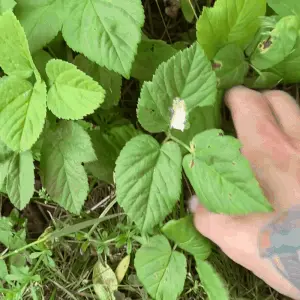
Resistant to Many Traditional Weeding Methods
- Simply pulling up the plant doesn’t work because the roots break apart easily and regenerate.
- Digging up the area may help, but unless you remove every last root fragment, the weed will return.
- Hoeing or rotavating can actually make things worse by breaking the rhizomes into smaller pieces, each capable of producing new growth.
Rapid Growth and Competition with Other Plants
- Ground elder outcompetes garden plants by taking up nutrients, water, and space.
- It grows in dense clusters, smothering nearby vegetation and making it hard for other plants to thrive.
- Even after clearing an area, ground elder can quickly recolonize it if left unchecked.
Limited Effectiveness of Natural Remedies
- Vinegar or boiling water may kill the leaves but won’t reach the underground rhizomes.
- Covering it with mulch or black plastic can help, but it needs to stay covered for at least 6-12 months to be fully effective.
- Hand removal and regular maintenance are essential to stopping regrowth.
Can You Ever Fully Remove Ground Elder?
- Completely eradicating ground elder is nearly impossible without ongoing maintenance, but you can keep it under control.
- Using a combination of manual removal, smothering techniques, and strategic planting can help limit its spread.
- The key is regular monitoring and maintenance—stay on top of it before it has a chance to take over again!
Understanding why ground elder is so difficult to remove is the first step in developing an effective long-term strategy. With persistence and the right approach, you can keep it from overwhelming your garden!
How to Get Rid of Ground Elder: Best Methods That Work
Ground elder (Aegopodium podagraria) is a persistent weed, but with the right approach and some patience, you can keep it from taking over your garden. Here are the most effective ways to tackle it.
Manual Removal: How to Get Rid of Ground Elder by Digging
- This is the most effective method, but it requires effort and persistence.
- Use a garden fork or weeding tool to loosen the soil and carefully follow the rhizomes.
- Remove as much of the root system as possible to prevent regrowth.
- Pro tip: Avoid breaking the roots—even tiny fragments can sprout new plants.
One of the most effective ways to get rid of ground elder is by carefully digging up its rhizomes and removing as much root as possible. When removing ground elder roots, use a garden fork to trace each white rhizome through the soil. Complete ground elder removal means following every root strand — even the smallest fragment can regrow.
How to Get Rid of Ground Elder with Smothering & Mulching
- Blocks sunlight, starving the plant over time.
- Cover affected areas with cardboard, thick mulch (at least 10-15 cm), or black plastic.
- Leave in place for at least 6-12 months for the best results.
- Best for: Large patches where digging isn’t practical.
If you’re looking for a non-invasive way to get rid of ground elder, smothering with mulch or black plastic is an effective solution.
Or for more ways to tackle weeds without chemicals, check out The Best Way to Get Rid of Weeds Naturally for effective, eco-friendly solutions.
Best Plants to Smother Ground Elder
The best plants to smother ground elder are vigorous, shade-tolerant species like ferns, geraniums, and hostas. These crowd out weeds, blocking sunlight and limiting space for regrowth. You can also sow wildflowers such as clover, vetch, or phacelia to create a dense, living barrier.
- Plant vigorous ground covers to crowd out ground elder and limit its spread.
- Good options include:
- Wildflowers (clover, vetch, phacelia)
- Hardy perennials (hostas, ferns, geraniums)
- Why it works: These plants compete for nutrients and block sunlight, making it harder for ground elder to thrive.
Regular Cutting and Maintenance
- Frequent cutting weakens ground elder by depleting its energy reserves.
- Mow regularly if it appears in your lawn.
- Combine with other methods for better long-term control.
Boiling Water & Vinegar – Do They Work?
- Boiling water: Scorches leaves but doesn’t reach the roots.
- Vinegar: Burns foliage but rhizomes survive underground, leading to regrowth.
- Best for: Small patches needing quick, temporary control.
For more info on chemical free weed removal, check out our article ‘ How to kill weeds naturally’
Chemical-Free Weed Barriers
- Physical barriers around garden beds stop rhizomes from spreading.
- Use deep-root barriers or buried metal sheets (at least 30 cm deep) for the best results.
Last Resort: Chemical Treatment
- Glyphosate-based weedkillers can kill ground elder, but use with caution.
- Works best when the plant is actively growing and before flowering.
- Why avoid it? Glyphosate can harm the environment and beneficial plants.
Best Weed Killer for Ground Elder
If you’re considering a weed killer for ground elder, choose one that targets the roots rather than just the leaves. Even the best weedkiller for ground elder won’t work instantly, but products containing glyphosate can penetrate rhizomes when applied carefully. Always apply to actively growing foliage and avoid contact with nearby plants.
💡 Tip: Organic gardeners can try fatty-acid or clove-oil-based formulas for a gentler alternative.
Does Boiling Water or Vinegar Help Get Rid of Ground Elder?
When battling ground elder (Aegopodium podagraria), many gardeners turn to natural, chemical-free solutions. Vinegar, boiling water, and other organic methods are often suggested, but how well do they actually work?
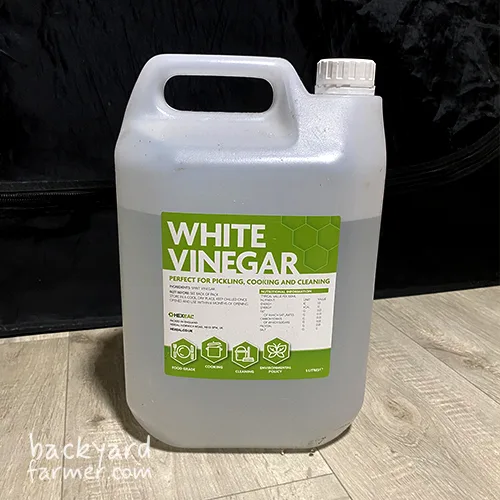
Vinegar as a Weed Killer
- Vinegar contains acetic acid, which burns and kills leaves on contact.
- Does it work? It damages foliage but doesn’t kill underground rhizomes, meaning the plant will regrow.
- Best for: Small, young shoots where an immediate top kill is needed.
- Downsides: Vinegar alters soil pH and can harm nearby plants if overused.
- Stronger options? Horticultural vinegar (20% acetic acid) is more powerful but still won’t reach the roots.
Boiling Water
- How it works: Scalds leaves and stems, temporarily weakening the plant.
- Limitations: Like vinegar, it won’t reach the deep rhizomes, so regrowth is inevitable.
- Best for: Small patches in paved areas or between cracks where other methods aren’t practical.
Mulching & Smothering
- How it works: Blocks sunlight, starving the plant over time.
- Best materials: Cardboard, thick mulch (10-15 cm), or black plastic.
- Effectiveness: Needs 6-12 months to fully deplete energy reserves.
- Best for: Large areas where manual removal isn’t practical.
Salt as a Weed Killer
- Does it kill ground elder? Yes, but at a cost.
- Major downside: Salt permanently damages soil, preventing anything else from growing.
- Not recommended for garden beds or areas where you want future plant growth.
Organic Herbicides
- Some commercial products use citrus-based acids or fatty acid solutions.
- Do they work? They weaken ground elder but don’t eliminate rhizomes, so regrowth is likely.
Can Natural Solutions Work?
- For short-term control: Vinegar, boiling water, and organic sprays can knock back growth but won’t prevent regrowth.
- For long-term removal: Digging, smothering, and consistent maintenance work best.
- Best strategy? A combination of methods provides the highest chance of success.
Why You Should Avoid Chemicals
When dealing with ground elder (Aegopodium podagraria), chemical herbicides might seem like a quick fix. But before reaching for glyphosate, it’s worth considering the downsides. While some weed killers can suppress ground elder, they often create more problems than they solve. Here’s why going chemical-free is the better choice.
If you’re considering chemical solutions, it’s important to understand their risks and regulations. Visit the UK Health and Safety Executive’s guide on pesticides to learn more about their safe use and environmental impact.
Environmental Impact
- Chemical herbicides leach into the soil, affecting beneficial microorganisms that keep your garden healthy.
- Runoff can pollute local water sources, harming fish, amphibians, and other aquatic life—especially in areas prone to heavy rain.
- Overuse of herbicides contributes to soil degradation, making it harder for other plants to thrive.
Non-Selective Damage
- Most weed killers don’t just target ground elder—they can kill nearby flowers, shrubs, and even grass.
- Spray drift can carry chemicals into neighboring gardens, unintentionally affecting plants.
- Some herbicides harm pollinators like bees and butterflies, disrupting the natural balance of your garden.
Ineffectiveness on Rhizomes
- Glyphosate-based herbicides only kill the leaves and stems but rarely reach the deep rhizomes underground.
- Even if the top growth dies, root fragments often survive and regrow, requiring repeated applications.
- Over time, excessive chemical use can negatively impact soil health and surrounding plant life.
Health Risks
- Prolonged exposure to herbicides has been linked to potential health risks for humans and pets.
- Many weed killers require protective gloves and masks for safe handling.
- Some studies suggest long-term concerns associated with glyphosate, making it a controversial option for home gardens.
Sustainable Alternatives Work Better
- Digging up rhizomes, mulching, and planting ground-cover plants are effective, eco-friendly ways to control ground elder.
- Instead of relying on chemicals, consistent maintenance keeps the weed in check without harming your garden’s ecosystem.
- Organic solutions create a healthier, more resilient garden without the risks that come with synthetic herbicides.
Can You Live with Ground Elder?
Ground elder (Aegopodium podagraria) is often seen as an invasive nuisance, but can you learn to live with it? While total eradication is difficult, some gardeners choose to manage it rather than fight an endless battle. Here’s how you can keep ground elder under control while making the most of its presence.
Accepting Ground Elder as Part of the Garden
- In some cases, ground elder can serve as ground cover, though it won’t completely prevent other weeds.
- It produces delicate white flowers, adding a wild, natural touch to cottage gardens.
- Its dense root system helps stabilize soil, but because of its aggressive spread, it’s not the best option for erosion control.
Keeping It Under Control
- Regular maintenance is key—frequent cutting or pulling prevents it from spreading too far.
- Mulching with thick organic material slows its growth and makes removal easier.
- Border barriers like deep edging help prevent rhizomes from creeping into unwanted areas.
- Planting vigorous competitors like ferns, hostas, or wildflowers limits its ability to take over.
Edible and Medicinal Uses
- Young ground elder leaves are edible and can be added to salads, soups, and stir-fries.
- Historically, it was used to treat gout and inflammation.
- It contains vitamin C and beneficial minerals, making it a nutritious choice for foragers.
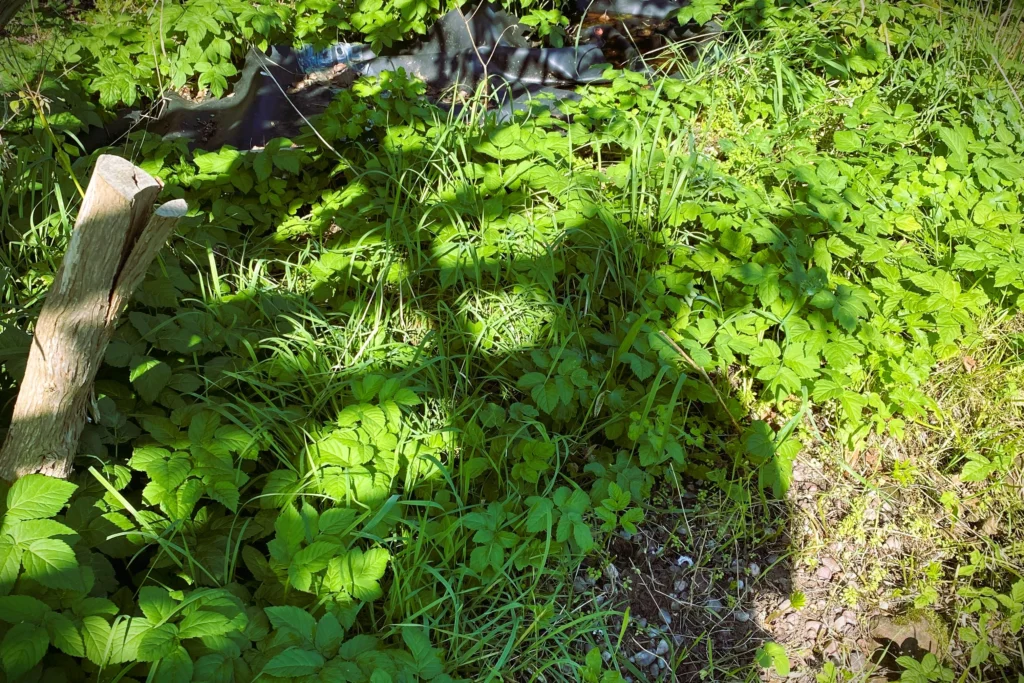
Creating Designated Areas for Ground Elder
- Some gardeners contain it in a specific area where it can grow without spreading uncontrollably.
- Designating a section of the garden for ground elder reduces the need for constant removal while allowing you to use it for culinary or ornamental purposes.
When It’s Best to Remove It
- If ground elder takes over flower beds, vegetable gardens, or high-maintenance areas, removal is usually the best choice.
- Large patches near structures or paved areas can become a problem if left unchecked.
Is Ground Elder Edible?
Ground elder (Aegopodium podagraria) is often seen as an invasive garden pest, but did you know it’s also a tasty and nutritious wild green? Historically, it has been used as both a food source and a medicinal herb. When harvested at the right time, ground elder can be a delicious and versatile ingredient in your kitchen.
Can You Eat Ground Elder?
- Absolutely! The young leaves are the best part to eat because they’re tender and mild.
- Older leaves can develop a slightly bitter taste, but they still work well in cooked dishes.
- The plant is completely non-toxic and has been safely consumed for centuries.
What Does Ground Elder Taste Like?
- Its flavor is often compared to parsley or celery, with a light aromatic touch.
- When cooked, it softens and takes on a spinach-like texture, making it perfect for sautés, soups, and stews.
How to Prepare and Use Ground Elder
- Raw in Salads – Finely chop young leaves and mix them into fresh greens.
- Sautéed or Steamed – Cook like spinach with butter or olive oil for a simple side dish.
- Soups and Stews – Toss in a handful of leaves for extra nutrients and flavor.
- Pesto Alternative – Blend with garlic, nuts, and olive oil for a fresh, earthy pesto.
- Herbal Teas – Dry the leaves and steep them for a soothing tea.
Nutritional and Medicinal Benefits
- Rich in Vitamin C – Supports a healthy immune system.
- Contains beneficial minerals – Provides essential nutrients for overall well-being.
- Anti-Inflammatory Properties – Traditionally used to help with gout and joint pain.
- Aids Digestion – Historically consumed for its mild digestive benefits.
Foraging and Harvesting Tips
- Pick young, tender leaves before the plant flowers for the best flavor.
- Always harvest from clean areas, away from roadsides and pesticide-treated zones.
- Rinse thoroughly before eating to remove dirt and debris.
Final Tips for Long-Term Ground Elder Control
Ground elder (Aegopodium podagraria) is a tough weed to beat, but with the right approach, you can keep it from taking over your garden. While completely eliminating it is difficult, a mix of strategies will help you stay in control. Here’s how to manage ground elder effectively over time.
No matter which method you choose, getting rid of ground elder requires regular monitoring to stop it from spreading again.
Stay Consistent with Manual Removal
- Dig out young plants before their roots spread too deep.
- Use a garden fork or weeding tool to carefully lift out as much of the root system as possible.
- Check treated areas often to catch regrowth before it gets out of hand.
Smother with Mulch or Coverings
- Apply a thick layer of organic mulch (wood chips, straw, or compost) to block sunlight and suppress new shoots.
- Use black plastic or landscape fabric for at least a year to deprive the plant of light and energy.
- For best results, mulch should be at least 10-15 cm deep.
Grow Competitive Plants
- Plant vigorous ground covers to crowd out ground elder and limit its spread.
- Some of the best options include ferns, hostas, geraniums, and dense wildflowers.
- A garden filled with strong, healthy plants makes it harder for ground elder to establish itself.
Regular Cutting and Mowing
- Trim ground elder often to drain its energy reserves and weaken growth.
- In lawn areas, set your mower to a low height and mow frequently.
- Regular cutting also prevents flowering, reducing the chances of seed spread.
Install Root Barriers
- Use deep root barriers (at least 30 cm deep) to prevent rhizomes from creeping into flower beds.
- Heavy-duty plastic or metal edging works best for blocking underground spread.
Monitor and Maintain
- Watch problem areas closely and remove any regrowth as soon as you spot it.
- Check pathways, borders, and edges regularly to prevent reinfestation.
- The key to success is persistence—each time you weaken the plant, you’re making progress!
Avoid Composting Ground Elder
- Never put ground elder roots or rhizomes in your compost bin unless you’re using a hot composting system.
- Compost piles must reach at least 55°C (130°F) to kill the rhizomes.
- If you’re unsure, dispose of ground elder in green waste bins or burn it to prevent spreading.
Use Chemicals as a Last Resort
- If absolutely necessary, use selective herbicides with caution and follow label instructions.
- Spot-treat problem areas instead of spraying large sections to minimize damage to other plants.
- Consider organic alternatives before turning to chemical solutions.
Ground Elder FAQs – How to Remove, Kill, and Compost It Safely
To get rid of ground elder in the UK, remove as much of the root system as possible, smother the area with mulch or tarps, and repeat the process over multiple seasons. Be persistent, as this invasive weed regrows easily from leftover rhizomes.
No method guarantees instant permanent removal, but combining digging, covering with light-blocking material, and planting strong competitors can suppress it. Glyphosate-based weedkillers work, but often need repeat applications.
Yes, you can use deep mulching, cardboard layering, and regular hoeing to weaken and eventually eliminate ground elder without chemicals. These methods require consistency but are effective over time.
You should not compost ground elder roots or rhizomes unless you use a hot composting method that reliably exceeds 60°C. Otherwise, the weed may survive and spread when you use the compost.
Young ground elder leaves are edible and were traditionally used in salads and soups. However, always ensure correct identification, as it resembles other toxic plants in the carrot family.
Boiling water or vinegar can damage the leaves, but they rarely kill the underground rhizomes. These methods may help weaken the plant when combined with digging or smothering.
Glyphosate-based weedkillers are commonly used and moderately effective. For organic gardeners, clove oil-based sprays or repeated manual methods are safer but slower.
Boiling water can scorch the leaves and stems, but it rarely kills the underground rhizomes. For lasting results, combine it with digging or smothering.
Vinegar burns the foliage but doesn’t reach the rhizomes. It’s best used for small, isolated patches or between paving cracks
Conclusion
Ground elder (Aegopodium podagraria) is a stubborn and fast-spreading weed, but with the right approach, you can keep it under control. While completely eliminating it may not be realistic, a mix of strategies will significantly reduce its spread and impact on your garden. The key is to stay proactive and consistent.
What Works Best?
- Manual removal – Carefully dig up rhizomes and remove as much root as possible.
- Mulching – Block sunlight to weaken regrowth and deplete the plant’s energy.
- Competitive planting – Grow strong, shade-producing plants to limit its spread.
- Regular maintenance – Monitor your garden and remove new shoots before they take hold.
Key Takeaways for Effective Control
✅ Consistency is key – The more often you remove regrowth, the weaker the plant becomes.
✅ Use barriers wisely – Deep root barriers or thick mulch can prevent ground elder from spreading into unwanted areas.
✅ Think twice about chemicals – Herbicides often fail to eliminate deep rhizomes and can harm beneficial plants and wildlife.
✅ It’s not all bad – Ground elder is edible and has medicinal uses, making it a resource for foragers and herbal enthusiasts.
By applying a combination of these methods, you can keep ground elder in check while maintaining a healthy, thriving garden. Whether you aim to remove it completely or simply manage its spread, persistence is the key to success.🌿 Happy gardening!
